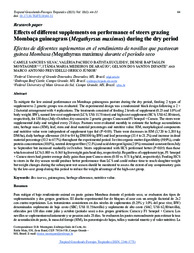Effects of different supplements on performance of steers grazing Mombaça guineagrass (Megathyrsus maximus) during the dry period.
Effects of different supplements on performance of steers grazing Mombaça guineagrass (Megathyrsus maximus) during the dry period.
Author(s): SILVA, C. S.; EUCLIDES, V. P. B.; MONTAGNER, D. B.; ARAÚJO, I. M. M. de; DIFANTE, G. dos S.; ORRICO JUNIOR, M. A. P.
Summary: ABSTRACT - To mitigate the low animal performance on Mombaça guineagrass pasture during the dry period, feeding 2 types of supplement to 2 genetic groups was evaluated. The experimental design was a randomized block design following a 2 × 2 factorial arrangement with 4 replications. The treatments consisted of feeding 2 levels of supplement (0.25 and 1.0% of body weight; BW), named low-cost supplement (LCS; US$ 11.75/steer) and high-cost supplement (HCS; US$ 62.80/steer), respectively, for 130 days (July–October; dry season) to 2 genetic groups: Caracu and F1 Senepol × Caracu. The steers were supplemented daily and weighed every 28 days. Pastures were evaluated monthly to estimate the herbage accumulation rate, herbage mass (HM), leaf, stem and dead material percentages and nutritive value. HM, morphological components and nutritive value were independent of supplement type fed (P>0.05). There were decreases in HM (3,720 to 3,205 kg DM/ha), daily herbage allowance (14.0 to 9.4 kg DM/100 kg BW) and leaf percentage (33.4 to 21.2%) and increase in dead material percentage (53.3 to 67.7%) throughout the experimental period. In vitro organic matter digestibility (59.9%), crude protein concentration (10.0%), neutral detergent fiber (72.1%) and acid detergent lignin (2.9%) remained constant from July to September but increased markedly in October. Steers supplemented with HCS performed better (P<0.05) than those which received LCS (1.005 vs. 0.565 kg liveweight gain/head/day, respectively). Regardless of supplement type, F1 Senepol × Caracu steers had greater average daily gains than pure Caracu steers (0.88 vs. 0.71 kg/hd/d, respectively). Feeding HCS to steers in the dry season would produce better performance than LCS and could reduce time to reach slaughter weight but weight changes during the subsequent wet season should be monitored to assess the extent of any compensatory gain by the low-cost group during this period to reduce the weight advantage of the high-cost group.
Publication year: 2021
Types of publication: Journal article
Unit: Embrapa Beef Cattle
Observation
Some of Embrapa's publications are published as ePub files. To read them, use or download one of the following free software options to your computer or mobile device. Android: Google Play Books; IOS: iBooks; Windows and Linux: Calibre.
Access other publications
Access the Agricultural Research Database (BDPA) to consult Embrapa's full library collection and records.
Visit Embrapa Bookstore to purchase books and other publications sold by Embrapa.

